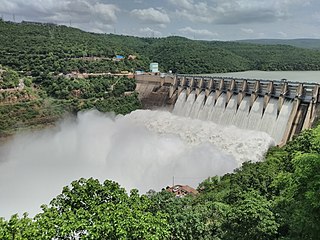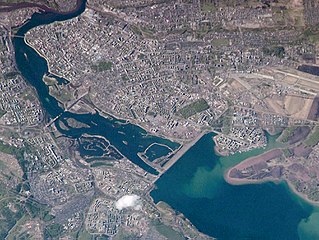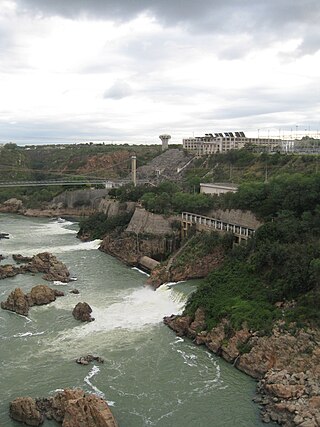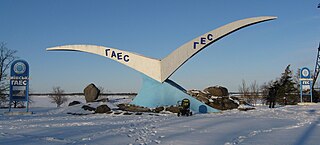
The Kurobe Dam (黒部ダム) or Kuroyon Dam (黒四ダム), is a 186 m (610 ft) high variable-radius arch dam on the Kurobe River in Toyama Prefecture, Japan. The tallest dam in Japan, it supports the 335 MW Kurobe No. 4 Hydropower Plant and is owned by Kansai Electric Power Company. It was constructed between 1956 and 1963 at a cost of ¥51.3 billion yen. The project was a difficult engineering feat for the rapidly growing post–World War II Japan, and claimed the lives of 171 people.

Tarbela Dam is an earth-filled dam along the Indus River in Pakistan's Khyber Pakhtunkhwa province. Located mainly in the Swabi district of the province, The dam is about 30 km (20 mi) from the city of Swabi, 105 km (65 mi) northwest of Islamabad, and 125 km (80 mi) east of Peshawar. It is the largest earth-filled dam in the world. The dam is 143 metres (470 ft) high above the riverbed and its reservoir, Tarbela Lake, has a surface area of approximately 250 square kilometres (97 sq mi).

GandhisagarDam is situated at a distance of 168 km from the District headquarter. The Dam is constructed on the Chambal River.

The Srisailam Dam is constructed across the Krishna River in Nagarkurnool district, Telangana and Nandyal district, Andhra Pradesh near Srisailam temple town and is the 2nd largest capacity working hydroelectric station in India.

The Bratsk Hydroelectric Power Station is a concrete gravity dam on the Angara River and adjacent hydroelectric power station. It is the second level of the Angara River hydroelectric station cascade in Irkutsk Oblast, Russia. From its commissioning in 1966, the station was the world’s single biggest power producer until Krasnoyarsk Hydroelectric Power Station reached 5,000 MW in 1971. Annually the station produces 22.6 TWh. Currently, the Bratsk Power Station operates 18 hydro-turbines, each with capacity of 250 MW, produced by the Leningrad Metal Works in the 1960s.

The Fierza Hydroelectric Power Station is a large hydroelectric power station on the Drin River, in Albania.

The Mingachevir Dam is an earth-fill embankment dam on the Kura River just north of Mingachevir in Azerbaijan. It serves several purposes to include hydroelectric power production and water storage for irrigation. The Mingachevir reservoir, behind the dam, supplies water to the Upper Qarabag and Upper Sirvan Channels which help irrigate about 1,000,000 ha of farmland in the country. Its six Francis turbine-generators were overhauled or replaced with 70 megawatts (94,000 hp) sets in 2000. Mingachevir reservoir has a storage capacity of 15.730 cubic kilometres (12,753,000 acre⋅ft), covering 605 km2 (234 sq mi). The length of the dam is 1,550 metres (5,090 ft), its width is 16 metres (52 ft) and height is 80 m (260 ft). It is the largest hydroelectric power station in the South Caucasus, is located over Kur river and not far from Mingachevir city.

The Boguchany Dam is a large hydroelectric dam on the Angara River in Kodinsk, Krasnoyarsk Krai, Russia. It has an installed capacity of 2,997 MW. Construction of the power plant was completed when a ninth and final generator was brought online in January 2015.

Seimare Dam, also known as Hini Mini or spelled Seymareh, is an arch dam on the Seimare River in Badreh County, Ilam Province, Iran. The primary purpose of the dam is hydroelectric power generation. Studies for the dam were carried out in the mid to late 1970s and construction began on the diversion works in 1997. In 2006, concrete placement began and on 19 May 2011, the dam began to impound the river. The dam's first generator became operational in 2013. The power plant, located downstream, houses three 160 MW Francis turbine-generators with an installed capacity of 480 MW.

The Irkutsk Hydroelectric Power Station is a rock-fill dam on the Angara River with an adjacent hydroelectric power station. It is located adjacent to Irkutsk, Irkutsk Oblast in Russia and is the first dam on the Angara cascades. Construction on the dam began in 1950, its reservoir began filling in 1956 and its first turbines were also commissioned in 1956. It was the first large hydroelectric power station constructed in Eastern Siberia and its completion was hailed by the Soviets as an engineering success.

The Paulo Afonso Hydroelectric Complex, also known as the Paulo Afonso Complex, is a system of three dams and five hydroelectric power plants on the São Francisco River near the city of Paulo Afonso in Bahia, Brazil. The complex exploits an 80-metre (260 ft) natural gap on the river, known as the Paulo Afonso Falls. Constructed in succession between 1948 and 1979, the dams support the Paulo Afonso I, II, III, IV and Apollonius Sales (Moxotó) power plants which contain a total of 23 generators with an installed capacity of 4,279.6 megawatts (5,739,000 hp).

The Itumbiara Dam is an embankment dam on the Paranaíba River near Itumbiara in Goiás, Brazil. The dam serves an associated hydroelectric power plant with a 2,082 megawatts (2,792,000 hp) installed capacity. The power plant is the sixth largest in Brazil and has the largest installed capacity of Eletrobrás Furnas' power plants.
The Wanjiazhai Dam is a gravity dam on the Yellow River on the border of Pianguan County, Shaanxi Province and Inner Mongolia Autonomous Region, China. The main purpose of the dam is water supply for the Wanjiazhai Water Control Project along with peak hydroelectric power generation. Construction on the dam began in 1994, the first generator went online in 1998 and the last in 2000.

The Okutadami Dam (奥只見ダム) is a concrete gravity dam on the Tadami River, 26 km (16 mi) east of Uonuma on the border of Niigata and Fukushima Prefectures, Japan. The primary purpose of the dam is hydroelectric power generation and it supports a 560 MW power station which is the largest conventional hydroelectric power station in Japan. The dam also forms the second largest reservoir in Japan, next to that of the Tokuyama Dam.

The Sup'ung Dam, also referred to as the Shuifeng Dam and originally the Suihō Dam, is a gravity dam on the Yalu River between Kuandian Manchu Autonomous County, Liaoning Province in China and Sakju County, North Pyongan Province in North Korea. The dam was constructed by the Japanese between 1937 and 1943 in order to generate electricity and has been repaired and renovated several times throughout the years, mainly due to spillway damage from flooding.

The Liyang Pumped Storage Power Station is a pumped-storage hydroelectric power station 22 km (14 mi) south of Liyang in Jiangsu Province, eastern China. Preliminary construction began in 2002 and major works started in May 2011. The first unit of the power station was commissioned in 2017, the power station will have an installed capacity of 1,500 MW.

Kyiv Hydroelectric Station is a run-of-river power plant on the Dnieper River in Vyshhorod, Ukraine. The 288 m (945 ft) long dam creates the Kyiv Reservoir with the purpose of hydroelectric power generation and navigability with the dam's associated lock. The first of 20 generators in the power station was commissioned in 1964, the last in 1968. Together with the Kyiv Pumped Storage Power Station, it creates a hydroelectricity generating complex. It is operated by the Ukrhydroenergo. Turbines for the plant were produced by the Kharkiv Factory Turboatom, and generators by the Kharkiv Factory "Elektrovazhmash".

The Kyiv Pumped-Storage Power Plant is a pumped-storage power station on the west bank of the Kyiv Reservoir in Vyshhorod, Ukraine. The Kyiv Reservoir serves as the lower reservoir and the upper reservoir is located 70 m (230 ft) above the lower. Water sent from the upper reservoir generates electricity with three 33.3 megawatts (44,700 hp) conventional hydroelectric generators and three 45 megawatts (60,000 hp) reversible pump generators. During periods of low demand, such as nighttime, the pump generators push water from the lower reservoir to the upper for use during peak hours. The first generator was commissioned in 1970, and the last in 1972.
The Kayrakkum Dam, also spelt variously as Kayrakum, Kairakum, Qayraqqum or Qayroqqum, is an embankment dam on the Syr Darya River near the town of Kayrakkum in Sughd Province, Tajikistan. It is situated on the western edge of the Fergana Valley and creates Kayrakkum Reservoir. The reservoir supplies water for irrigation, primarily in Uzbekistan downstream, and hydroelectric power production. The reservoir is also a Ramsar site. The dam's power station has an installed capacity of 126 MW and is operated by Barki Tojik. Construction on the dam began in 1952. It began to impound its reservoir in 1956 and the first two generators were commissioned that year. The other four were operational in 1957 and the project was complete in 1959. The power station is currently undergoing a rehabilitation which should be completed in 2020. Two new and larger turbines will increase the installed capacity to 142 MW.

The Kulekhani Dam is a rock-fill dam on the Kulekhani River near Kulekhani in Makwanpur District of Narayani Zone, Nepal. The primary purpose of the dam is hydroelectric power generation and it supports the 60 MW Kulekhani I and 32 MW Kulekhani II Hydropower Stations. Construction began in 1977 and Kulekhani I was commissioned in 1982. Kulekhani II was commissioned in 1986 and a third power station, the 14 MW Kulekhani III was expected to be commissioned in May 2015 but was delayed due to issues with the builder. The US$117.84 million project received funding from the World Bank, Kuwait Fund, UNDP, Overseas Economic Cooperation Fund and OPEC Fund. It is owned by Nepal Electricity Authority.




















